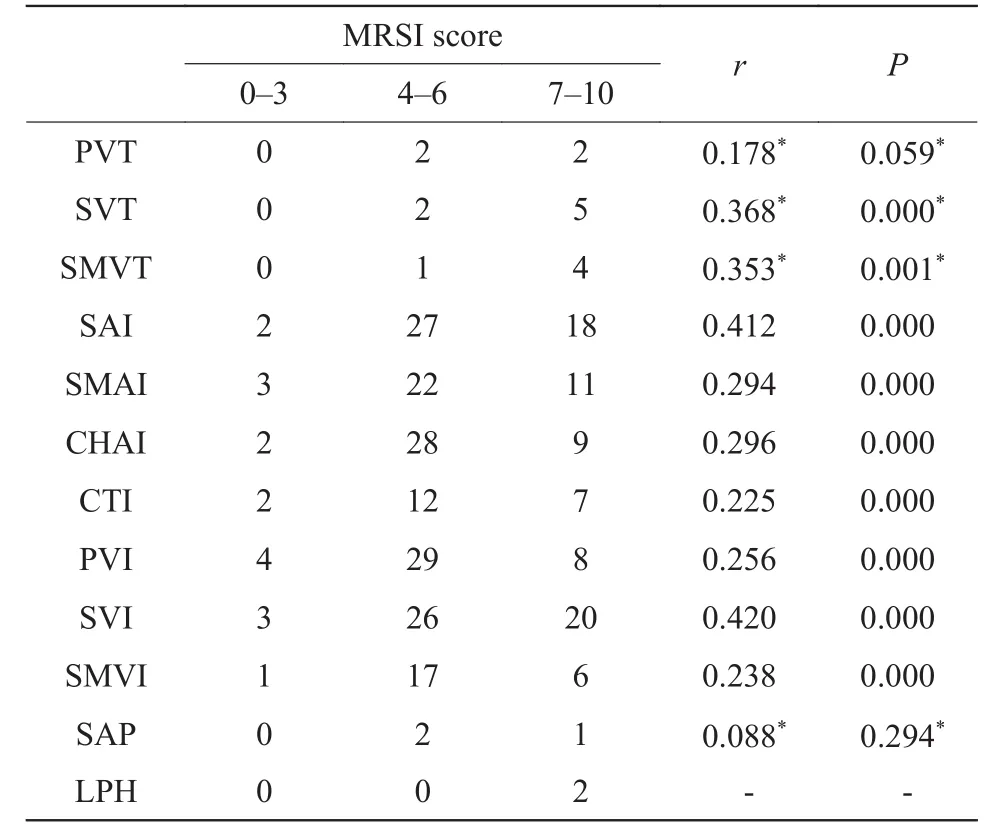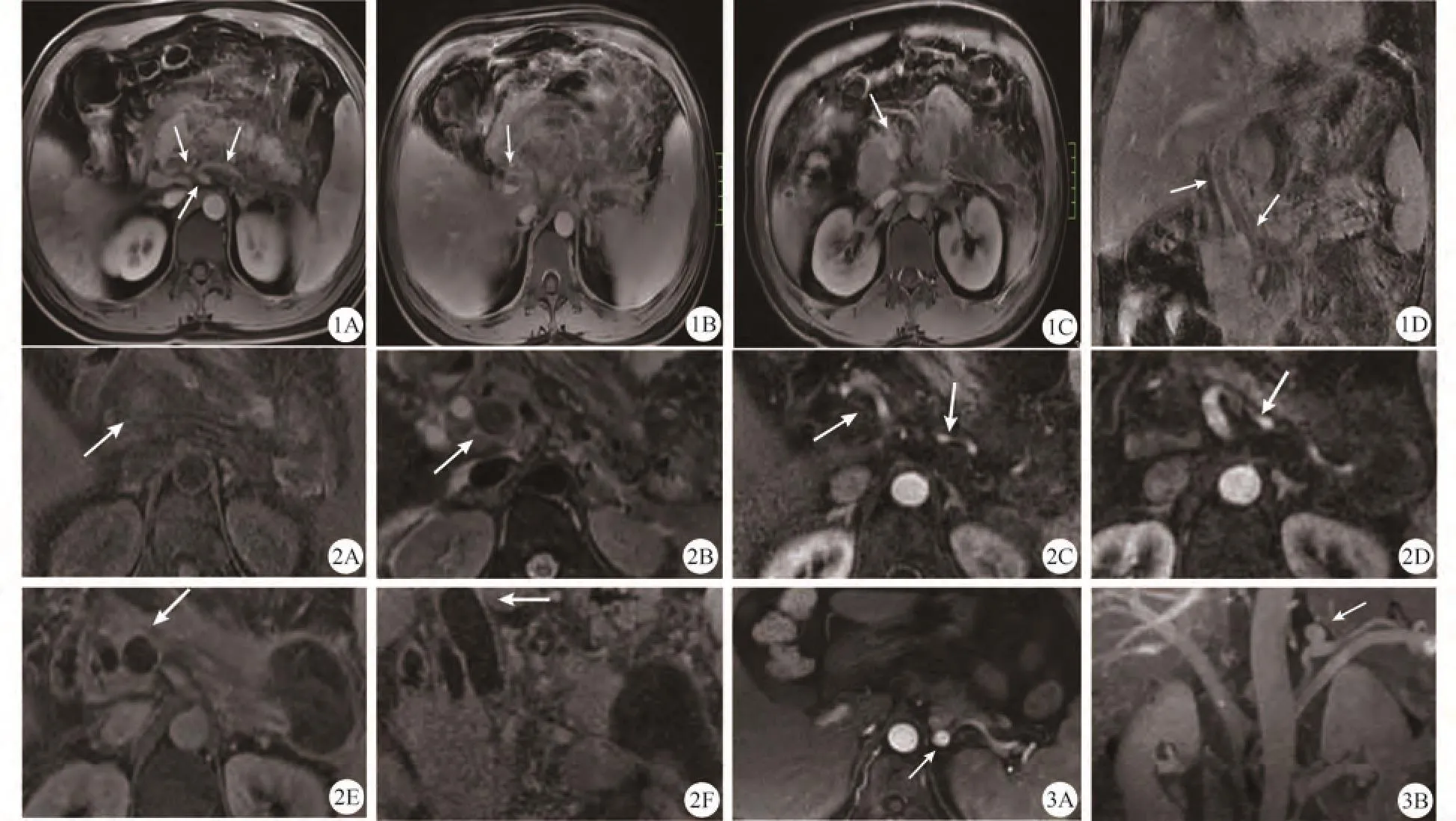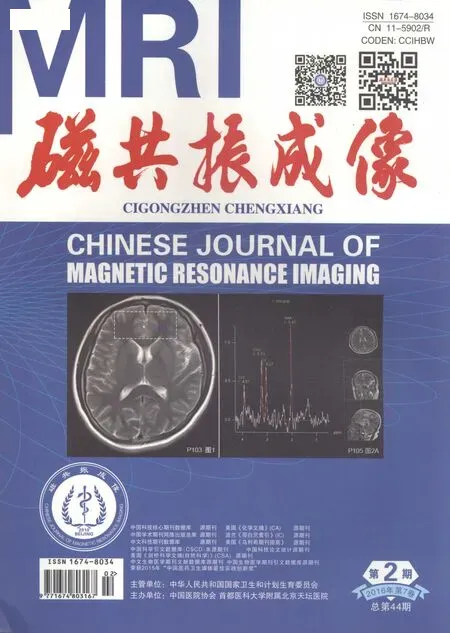急性胰腺炎胰周血管受累的磁共振表现
赵强,张小明
急性胰腺炎胰周血管受累的磁共振表现
赵强1,张小明2*
[摘要]目的 探讨急性胰腺炎(acute pancreatitis, AP)胰周血管受累的磁共振表现、发生率;胰周血管受累与磁共振严重指数(magnetic resonance severity index,MRSI)的相关性研究。材料与方法 收集川北医学院附属医院2009年8月至2013年8月期间326例AP患者资料。所有病例均签署知情同意书。AP患者均在住院后3天内行腹部平扫加增强检查。观察AP的MRI表现,行MRSI评分,观察AP的胰周血管异常表现,用Spearman法统计分析血管并发症与MRSI评分的相关性。结果 326例AP患者中,轻度、中度、重度AP患者胰周血管并发症发生率分别为3%(4/124)、17%(31/180)、91%(20/22)。其中脾静脉血栓7例、肠系膜上静脉血栓5例、脾动脉受侵(炎症)47例、脾静脉受侵(炎症)49例,以上血管并发症在MRSI评分轻、中、重度患者中发生率差异具有统计学意义,并与MRSI评分呈正相关(P<0.05,0.3<r<0.5);腹腔干受侵(炎症)21例、门静脉受侵(炎症)41例、肝总动脉受侵(炎症)39例、肠系膜上动脉受侵(炎症)36例、肠系膜上静脉受侵(炎症)24例,以上并发症在MRSI评分轻、中、重度患者中发生率差异具有统计学意义,但与MRSI评分无明显相关性(P<0.05,r<0.3);门静脉血栓4例、脾动脉假性动脉瘤3例,其发生率差异不具有统计学意义,与MRSI评分也无明显相关性(P>0.05,r<0.3)。结论 AP的胰周血管并发症较为常见,脾静脉血栓、脾动静脉炎症、肠系膜上静脉血栓与急性胰腺炎的严重程度呈正相关,可以作为一个早期预测AP严重程度的指标。
[关键词]急性胰腺炎;磁共振成像;胰周血管并发症;磁共振严重指数
作者单位:1. 重庆市北部新区第一人民医院放射科,重庆 401121 2. 川北医学院附属医院放射科,南充637000
接受日期:2015-12-30
赵强, 张小明. 急性胰腺炎胰周血管受累的磁共振表现. 磁共振成像, 2016,7(2): 121–125.
*Correspondence to: Zhang XM, E-mail: cjr.zhxm@vip.163.com
Received 7 Dec 2015, Accepted 30 Dec 2015
急性胰腺炎(acute pancreatitis, AP)是临床常见的急腹症,并发症包括假性囊肿、胰周血管并发症等[1-3]。胰周血管并发症的机制可能是AP时渗出胰酶对胰周血管的直接损伤所致[4],胰腺炎总的胰周血管并发症发生率约1.2%~14%[5-6],假性动脉瘤破裂出血导致的死亡率远高于未出血患者[6]。CT对AP的诊断、严重度的评价均有较高的价值[7-9],Balthazar[8-9]提出的CT严重指数(CT severity index, CTSI)能够判断重症AP的预后,CT增强能够很好地显示AP的血管并发症[10],然而CT检查有电离辐射且碘对比剂可能加重AP的病情[11-12]。血管造影虽是血管病变诊断的金标准,然而属于有创性检查。MRI检查具有无电离辐射、良好的软组织对比、对比剂安全等优点,已越来越普遍地应用于AP的诊断及严重程度的评价。磁共振严重指数(MR severity index, MRSI)在评价AP严重度方面与CTSI有相似的效能[13];MRI平扫在鉴别AP严重度方面比CT增强更可靠[14],在显示轻度AP、AP并发症等方面比CT敏感[15];磁共振增强对胰周血管具有良好的显示率[16]。对于AP血管并发症CT研究较多,磁共振研究较少,对AP血管并发症与MRSI之间的相关性研究还没有文献报道过,本文将对此做相关研究。
1 材料与方法
1.1研究对象
回顾性分析2009年8月至2013年8月在川北医学院附属医院住院,并做磁共振平扫加增强的357例AP患者资料。排除了31例,其中肝癌3例,合并胰腺癌9例,胃癌1例,肝硬化10例,临床资料不全8例。最终纳入研究包括326例AP患者,其中男性161例,女性165例,年龄17~88岁,平均(53 ± 15)岁。病因:胆源性57.9%(189/326),高脂饮食16.6%(54/326),酒精性7.4%(24/326),手术引发1.8%(6/326),特发性16.3%(53/326)。所有病例均签署知情同意书。
纳入标准:满足AP的诊断标准[17];发病后3天内上腹部磁共振平扫加增强检查;既往无胰周血管疾病及手术史。
排除标准:图像质量欠佳,影响图像观察;合并胰腺癌的胰腺炎;临床资料不完整;腹腔、腹膜后肿瘤;肝硬化。
1.2MRI检查技术
检查机型包括GE Signa Excite 1.5 T和GE 3.0 T Discovery MR750型两种超导全身磁共振扫描仪。三维肝脏容积快速采集(3D liver acquisition with volume acceleration, LAVA)序列,三期动态增强包括动脉期、胰期、静脉期,180 s后进行延迟期扫描。动脉期采集应用GE Smartprep软件,自动跟踪触发采集,每一时相采集时间约13~18 s。对比剂为马根维显(0.2 mmol/kg,20 ml),经肘正中静脉Medrad公司磁共振专用高压双管注射器注射,速度3.0~3.5 ml/s,注射完后以相同速度20 ml生理盐水冲洗。
1.3MRI图像分析
在售后服务方面,劲豹强调的是完善的售后服务所带给客户的信任感和安全感,每一次满意的客户消费体验背后,都是企业上下员工的努力,也是公司不断衍生、进化新产品的机会之所在。 “没有100%的产品,只有100%的服务。只有生根在这个行业里,才有可能脱颖而出。”方新通追求极致产品体验、探索无限创新可能的精神,深深地打动了我们。“行远必自迩、追求无止境”,这正是劲豹的长存之道。
患者的原始图像中,1.5 T的上传至工作站(GE, AW4.1, Sun Microsystems, Palo Alto, CA)进行分析,3.0 T的上传至工作站(GE, AW4.4)进行分析。由两名从事腹部MRI诊断的高年资医师在不知道患者临床资料(临床表现、实验室检查)的情况下独立对MRI图像进行分析,结果不一致时由双方协商达成一致。
MRSI分值由炎症程度和坏死程度两部分组成,炎症程度:正常胰腺0分,局部或弥漫性胰腺肿大1分,胰周脂肪内条片状异常信号2分,单一界限不清的浆膜腔积液3分,两个或以上界限不清的浆膜腔积液或在胰腺内或胰周出现气体4分;坏死程度:无坏死0分,坏死小于30%为2分,坏死30%~50%为4分,坏死大于50%为6分,两部分相加即MRSI分值,总分10分。根据MRSI评分,将AP分为:轻度(0~3分)、中度(4~6分)、重度(7~10分)[7]。
1.4统计学分析
Kappa检验分析两名医师观察结果的一致性:K≥0.75说明一致性良好,0.4<K<0.75说明一致性一般,K≤0.4则一致性较差。

表1 两名医师对于胰周血管并发症观察的一致性Tab. 1 The consistency of two physicians for the observation of the peripancreatic vascular involvement
患者年龄、MRSI评分用均数 ± 标准差表示。计算AP胰周血管并发症的发生率;卡方检验或Fisher确切概率法评价MRSI评分轻、中、重度患者胰周血管并发症发生率是否有差异;Spearman非参数检验评价胰周血管并发症与MRSI的相关性,r<0.3时没有相关性,0.3≤r <0.5时为低度相关,0.5≤r<0.8为中度相关,r≥0.8为高度相关。本研究所有统计学检验均应用SPSS 19统计软件,P<0.05为统计学有意义。
2 结果
2.1AP的MRI表现
2.2胰周血管并发症
16.9%(55/326)的AP患者至少出现一项胰周血管并发症。两名医师对AP胰周血管并发症诊断的一致性良好(kappa≥0.75)。12%(32/267)的急性间质性AP患者发生胰周血管并发症,39%(23/59)的坏死性AP患者发生胰周血管并发症,二者之间的差异具有统计学意义(P<0.05)。轻度、中度、重度A P患者胰周血管并发症发生率分别为3%(4/124)、17%(31/180)、91%(20/22)。轻度、中度、重度AP胰周血管并发症发生率见表2。

表2 AP胰周血管并发症与MRSI评分关系Tab. 2 Relationship between pancreatic vascular involvement of AP and MRSI score
3 讨论
对于AP时胰周血管的化学性炎症的磁共振表现,国内有少量文献报道[18],主要表现为平扫T1WI和T2WI血管腔内失去正常的流空信号,呈局部“白血”信号,增强后动脉期血管壁毛糙,管腔狭窄或血管内强化不均匀,见图1、2。本研究发现随着AP病情的加重,血管炎症发生率上升,其中脾动脉炎、脾静脉炎在MRSI评分轻、中、重度患者的发生率差异具有统计学意义,并与MRSI评分呈正相关,这可能是因为脾动脉、脾静脉与胰腺的解剖关系更紧密,更能反映AP的严重程度。
Bergert等[19]报道AP的假性动脉瘤发病率约为5%,而Dörffel等[20]通过超声报道189例AP患者中发现13例假性动脉瘤(6.9%),Kirby等[2 1]在Ranson评分大于3分的重症AP中假性动脉瘤发生率约10%。本研究的发病率较低约1%(仅3例),见图3,其原因可能是重症患者少。本研究检查均在发病3天内检查,而动脉瘤的形成可能需要较长的时间,Dörffel等[20]通过超声发现假性动脉瘤形成的时间是3~5周。由于脾动脉紧邻胰腺走行,因此脾动脉最易受累,其后依次是胃十二指肠动脉、胰十二指肠动脉、胃左动脉、肝总动脉[22]。本研究3例动脉瘤均为脾动脉假性动脉瘤。

图1 男,33岁,急性胰腺炎。A:动脉期增强示腹腔干、肝总动脉、脾动脉受侵;B、C:横断位门脉期增强示门静脉、肠系膜上静脉血栓;D:冠状位延迟期示门静脉、肠系膜上静脉血栓 图2 女,60岁,急性胰腺炎,门静脉血栓伴动脉炎症。A:T1WI门静脉流空信号消失,呈稍高信号;B:T2WI门静脉内呈稍低信号;C、D:动脉期增强示脾动脉、肠系膜上动脉、肝总动脉管壁毛糙,强化不均匀;E、F:门脉期横断位及延迟期冠状位示门静脉充盈缺损,胰尾见假性囊肿 图3 女,54岁,急性胰腺炎,横断位动脉期(A)、冠状位门脉期(B)示脾动脉假性动脉瘤Fig. 1 Thirty-three year old man, acute pancreatitis. A: Arterial phase showed CTI, CHAI, SAI; B, C: Cross sectional portalvenous phase showed PVT and SMVT; D: Coronary delayed phase showed PVT and SMVT. Fig. 2 Sixty year-old woman, AP with PVT and arterial invasion. A: T1WI showed portal vein flow void signal disappeared, slightly high signal; B: T2WI showed slightly lower signal in the portal vein; C, D: Arterial phase showed the wall of SA, SMA, CHA was rough and uneven enhancement; E, F: The portal-venous phase transverse and coronal delayed phase showed portal vein filling defect, pseudocyst of the tail of the pancreas. Fig. 3 Fifty-four year old woman, AP, transverse artery phase(A) and coronal portal-venous phase(B)showed SAP.
Rebours等[23]认为血栓形成的机制主要是胰周炎症反应以及坏死组织、囊肿对胰周静脉的压迫。Harris等[24]在其发现的45例血栓中,AP发病时仅发现8例,发病1个月内发现19例,一个月至一年内发现18例。本研究磁共振检查均在3天内进行,并且重症患者少,所以本研究的血栓发生率偏低(14/326)。与文献报道[25]一致,脾静脉血栓最常见,有7例,其次是肠系膜上静脉5例(图1),门静脉4例(图1、2)。血栓均出现在中、重度患者,轻度患者没有发现血栓。与Mortelé等[4]的研究一致,脾静脉血栓、肠系膜上静脉血栓发生率与AP的严重程度有关,与MRSI评分呈正相关,而门静脉血栓发病率与AP的严重程度无关,与MRSI评分没有相关性,原因可能是门静脉较之脾静脉、肠系膜上静脉离胰腺较远,更容易受全身炎症反应导致的血液浓缩、血液粘滞度增加影响有关。
综上所述,AP时胰周血管并发症较为常见,总的发生率约16.9%,每种并发症在磁共振上均有较特异的表现。脾静脉血栓、肠系膜上静脉血栓、脾动脉及静脉炎症的发生率与MRSI评分呈正相关,可以作为评价AP严重程度的辅助指标,指导临床治疗方案的选择。
参考文献[References]
[1]Bruennler T, Langgartner J, Lang S, et al. Outcome of patients with acute, necrotizing pancreatitis requiring drainage-does drainage size matter. World J Gastroenterol, 2008, 14(5): 725.
[2]Luo Y, Yuan CX, Peng YL, et al. Can ultrasound predict the severity of acute pancreatitis early by observing acute fluid collection. World J Gastroenterol, 2001, 7(2): 293-295.
[3]Zerem E, Imamović G, Sušić A, et al. Step-up approach to infected necrotising pancreatitis: a 20-year experience of percutaneous drainage in a single centre. Dig Liver Dis, 2011,43(6): 478-483.
[4]Mortelé KJ, Mergo PJ, Taylor HM, et al. Peripancreatic vascular abnormalities complicating acute pancreatitis:contrast-enhanced helical CT findings. Eur J Radiol, 2004, 52(1): 67-72.
[5]van Santvoort HC, Besselink MG, Bakker OJ, et al. A step-up approach or open necrosectomy for necrotizing pancreatitis. N Engl J Med, 2010, 362(16): 1491-1502.
[6]van Santvoort HC, Bakker OJ, Bollen TL, et al. A conservative and minimally invasive approach to necrotizing pancreatitis improves outcome. Gastroenterology, 2011, 141(4): 1254-1263.
[7]Balthazar EJ, Megibow AJ, Robinson DL, et al. Acute pancreatitis: value of CT in establishing prognosis. Radiology,1990, 174(2): 331-336.
[8]Balthazar EJ. Acute pancreatitis: assessment of severity with clinical and CT evaluation. Radiology, 2002, 223(3): 603-613.
[9]Balthazar EJ, vanSonnenberg E, Freeny PC. Imaging and intervention in acute pancreatitis. Radiology, 1994, 193(2): 297-306.
[10]Urban BA, Curry CA, Fishman EK. Complications of acute pancreatitis: helical CT evaluation. Emerg Radiol, 1999, 6(2): 113-120.
[11]Viremouneix L, Gautier G, Monneuse O, et al. Prospective evaluation of nonenhanced MR imaging in acute pancreatitis. J Magn reson imaging, 2007, 26(2): 331-338.
[12]Arvanitakis M, Gantzarou A, Koustiani G, et al. Staging of severity and prognosis of acute pancreatitis by computed tomography and magnetic resonance imaging-a comparative study. Dig Liver Dis, 2007, 39(5): 473-482.
[13]Kim YK, Han YM, Kim CS. Role of fat-suppressed t1-weighted magnetic resonance imaging in predicting severity and prognosis of acute pancreatitis: an intraindividual comparison with multidetector computed tomography. J Comput assist tomogr, 2009, 33(5): 651-656.
[14]Pan HS, Zhang XM. MR imaging evaluation of acute pancreatitis. Int J Med Radio, 2010, 33(1): 34-37.潘华山, 张小明. 急性胰腺炎的MRI评价. 国际医学放射学杂志, 2010, 33(1): 34-37.
[15]Zhao Q, Zhang XM, Zeng NL. Display of 3.0 T magnetic resonance in normal pancreatic direct supplying arteries. Chin J Magn Reson Imaging, 2013, 4(6): 401-404.赵强, 张小明, 曾南林. 3.0 T MRI对正常胰腺直接供血动脉的显示. 磁共振成像, 2013, 4(6): 401-404.
[16]Banks PA, Dervenis C, Bollen TL, et al. Classification of acute pancreatitis- 2012: revision of the Atlanta classification and definitions by international consensus. Gut, 2013, 62(1): 102-111.
[17]Xiao B, Jiang ZQ, Zhang XM. Complications of acute pancreatitis: MRI findings of peripancreatic vascular disorders. J Clin Radiol, 2011, 30(11): 1625-1628.肖波, 蒋志琼, 张小明. 急性胰腺炎的并发症: 胰周血管疾病的MRI表现. 临床放射学杂志, 2011, 30(11): 1625-1628.
[18]Bergert H, Hinterseher I, Kersting S, et al. Management and outcome of hemorrhage due to arterial pseudoaneurysms in pancreatitis. Surgery, 2005, 137(3): 323-328.
[19]Dörffel T, Wruck T, Rückert RI, et al. Vascular complications in acute pancreatitis assessed by color duplex ultrasonography. Pancreas, 2000, 21(2): 126-133.
[20]Kirby JM, Vora P. Vascular complications of pancreatitis: imaging and intervention. Cardiovasc Intervent Radiol, 2008,31(5): 957-970.
[21]Suzuki T, Ishida H, Komatsuda T, et al. Pseudoaneurysm of the gas¬troduodenal artery ruptured into the superior mesenteric vein in a patient with chronic pancreatitis. J Clin Ultrasound,2003, 31(5): 278-282.
[22]Rebours V, Boudaoud L, Vullierme MP, et al. Extrahepatic portal venous system thrombosis in recurrent acute and chronic alcoholic pancreatitis is caused by local inflammation and not thrombophilia. Am J Gastroenterol, 2012, 107(10): 1579-1585.
[23]Harris S, Nadkarni, Naina HV, et al. Splanchnic vein thrombosis in acute pancreatitis: a single-center experience. Pancreas, 2013,42(8): 1251-1254.
[24]Bernades P, Baetz A, Levy P, et al. Splenic and portal venous obstruction in chronic pancreatitis. A prospective longitudinal study of a medical surgical series of 266 patients. Dig Dis Sci,1992, 37(3): 340-346.
Peripancreatic vascular involvement in acute pancreatitis: a MRI study
ZHAO Qiang1, ZHANG Xiao-ming2*1Department of Radiology, First people’s Hospital of Chong Qing New North Zone,Chongqing 401121, China2Department of Radioloy, Affiliated Hospital of North Sichuan Medical College,Nanchong 637000, China
Key wordsAcute pancreatitis; Magnetic resonance imaging; Peripancreatic vascular involvement; MR severity index
AbstractObjective: To study MRI findings of peripancreatic vascular involvement in acute pancreatitis(AP) as well as correlations between vascular involvement and the severity of acute pancreatitis according to the magnetic resonance severity index(MRSI). Materials and Methods: A total of 326 patients with AP admitted to our institution from August 2009 to August 2013 were included in this study. All cases signed informed consent. MRI plain scan and enhanced scan were performed within 72 hours after admission. MRI findings of acute pancreatitis were noted. The peripancreatic vascular involvement was noted in AP on MRI. Spearman correlation of peripancreatic vascular involvement with the MRSI scores were analyzed. Results: At mild, moderate and severe AP according to MRSI, the prevalence of peripancreatic vascular involvement were 3%(4/124), 17%(31/180), 91%(20/22) respectively in 326 patients. The prevalence among splenic vein thrombosis(7 patients), superior mesenteric vein thrombosis(5 patients), splenic vein invasion(49 patients), splenic artery invasion(47 patients) at mild, moderate and severe AP according to MRSI had statistics differences and was positively correlated with the MRSI score (P<0.05,0.3<r<0.5). The prevalence among celiac trunk invasion (21 patients), portal vein invasion (41 patients), common hepatic artery invasion (39 patients), superior mesenteric artery invasion (36 patients), superior mesenteric vein invasion (24 patients) at mild, moderate and severe AP according to MRSI had statistics differencesand was not positively correlated with the MRSI score (P<0.05, r<0.3). The prevalence among portal vein thrombosis (4 patients), splenic artery pseudoaneurysm (3 patients) at mild, moderate and severe AP according to MRSI had not statistics differences and was not positively correlated with the MRSI score (P>0.05, r<0.3). Conclusions: Some patients with AP show peripancreatic vascular involvement on MRI. The prevalence of splenic vein thrombosis, superior mesenteric vein thrombosis,splenic vein invasion and splenic artery invasion has a positive correlation with the severity of AP on MRI.
通讯作者:张小明,E-mail:cjr.zhxm@vip.163.com
收稿日期:2015-12-07
中图分类号:R445.2;R576
文献标识码:A
DOI:10.12015/issn.1674-8034.2016.02.007

